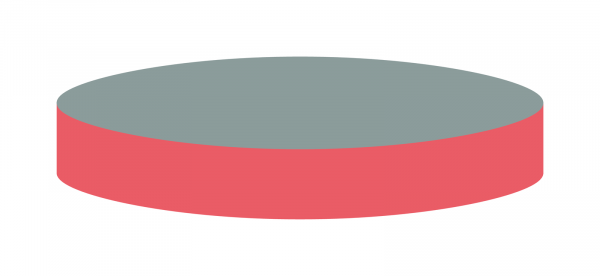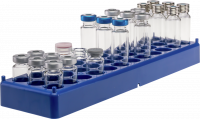Screw closure, N 18, metal (magn.), silver, closed top,Butyl red/PTFE gray,1.5mm
*taxes and shipping not included
Delivery time approx. 5 working days
| Quantity | Price/unit |
|---|---|
| To 9 | $70.20 |
| From 10 | $59.70 |
| From 50 | $53.85 |
Closed top screw closure for screw neck vials N 18 for sample storage / transportation. By changing to an appropriate open top screw closure you may carry out afterwards a Headspace analysis without the need of sample transfer on instruments that are suitable for this vial type.
| Closure type | Screw closure |
| Nominal diameter | N 18 |
| Assembling process | Assembled |
| Cap material | Metal (magnetic) |
| Cap color | Silver |
| Cap hole | No |
| Closure magnetic | Yes |
| Septa material | Butyl/PTFE |
| Colors of septa material | Red/gray |
| Septa thickness | 1.5 mm / 59,1 mil |
| Septa hardness | 50° shore A |
| Additional cap features | Non-standardized precision thread |
| Additional closure features | Temp. resistance -40 °C up to 120 °C / analytical purity - medium |
| Recommended application(s) | Sample storage |
| Storage temperature | 15–25 °C / 59–77 °F |
| Scope of delivery | 100x N 18 ready assembled screw closures |
| Gross weight (incl. packaging) | 200 g / 0.44 lbs |
| Packaging dimensions | 200 x 150 x 25 mm / 7.87 x 5.91 x 0.98 Inch |
| Hazardous material | No |
Robotic sample preparation lines as well as some autosamplers are constructed that way that they lift and transport vials with a magnet the size of the vial’s cap. In these cases aluminum crimp or plastic screw caps cannot be used, as these materials won’t react to a magnet. Only metals like steel or tin will do so, however, they will also bear some problems that need to be considered.
One of the most wellknown autosamplers with such a transportation system is the CTC PAL* for GC and Headspace. There are a lot of OEM versions of that autosampler in the market as well as identically constructed ones, but they all have in common that they require caps reacting to a magnet for transportation of vials from the rack into the heating chamber.
Magnetic closures for CTC Combi / GC PAL* and identically constructed autosamplers
For crimp neck vials N 11 and N 20 you will find magnetic crimp caps that are made from steel or tin. In contrast to alumi-num they are fairly hard to crimp and their edges cannot be crimped so smoothly and tightly around the glass crimp neck as you can do with the soft aluminum. Even battery-powered crimping tools do not have enough power to crimp such closures. While magnetic crimp closures are a solution for the instrument, the users are often frustrated by the inconvenient handling and by tightness / crimping problems.
At least for the crimp neck vials N 20 the bi-metal crimp closures seemed to offer improvements, as they consist of an aluminum and a tin part. While the cap side that needs to be crimped is made from aluminum, the cap’s surface that gets into contact with the magnet is mainly made from tin. This way needs of the instrument as well as of users should have been addressed to with this type of closure. However, when trying to decap a vial with bi-metal closure, the hard tin inlay interferes with the movement of the decapping head’s jaws that want to pull up the aluminum from the vial’s crimp neck.
Analogous to the 11 mm magnetic crimp closure 702879, the magnetic screw closure 702155 can be used on all autosamplers that transport 1.5 mL vials via a magnet (e.g. CTC GC PAL*). The blue PP screw cap with a silver, pressed on and firmly fixed metal top allows a convenient and easy screwing onto the vial. Like the magnetic crimp closure, it contains a Silicone white/PTFE red septum with high analytical purity. Due to its low thickness (1.0 mm) and its softness the septum is safe to penetrate. A slit Silicone/PTFE version is also availalble (702156). Upon request we can supply the magnetic screw closures also with other septa materials.
For Headspace analysis you find 18 mm metal screw closures as an alternative to 20 mm bi-metal or magnetic crimp closures. They offer a more convenient, consistent, and safer sealing process compared to crimping (better reproducibility). Due to the thinner septum (1.5 instead of 3 mm), penetration of the needle is easier and executed with less fragmentation (especially important for SPME applications). They offer a flat surface for the magnet; consequently the filled vial cannot drop from the magnet which may be the case with over-crimped vials due to the associated convexity of the cap.
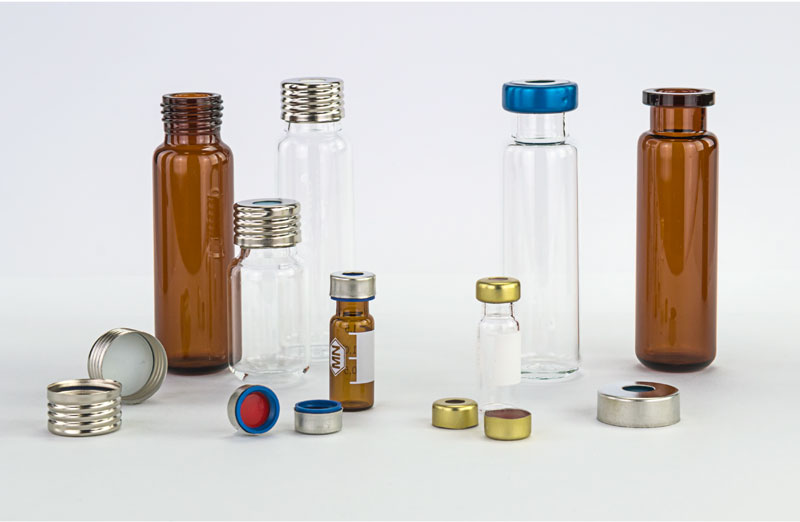
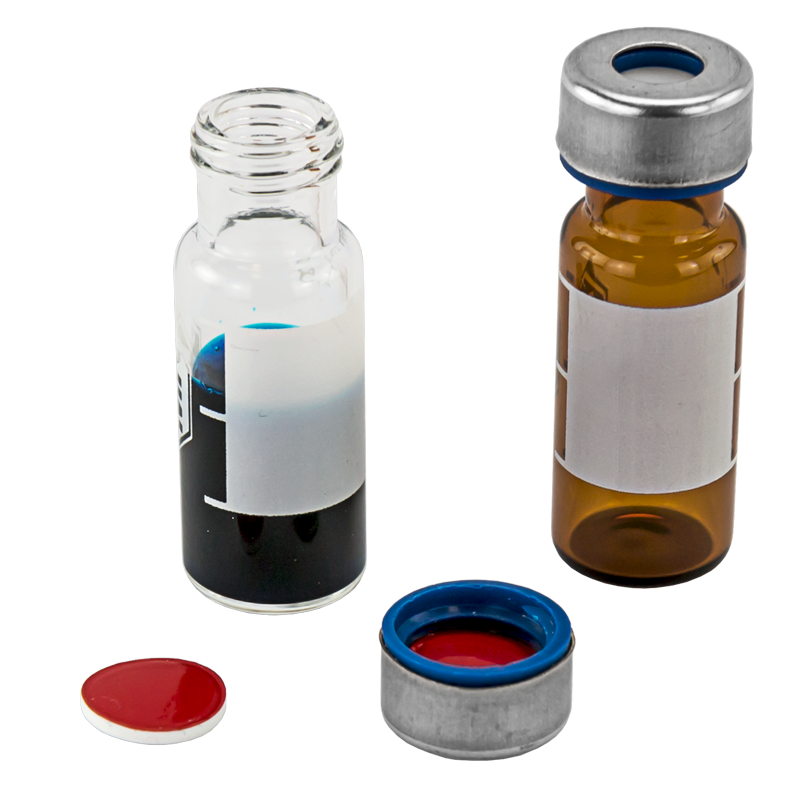
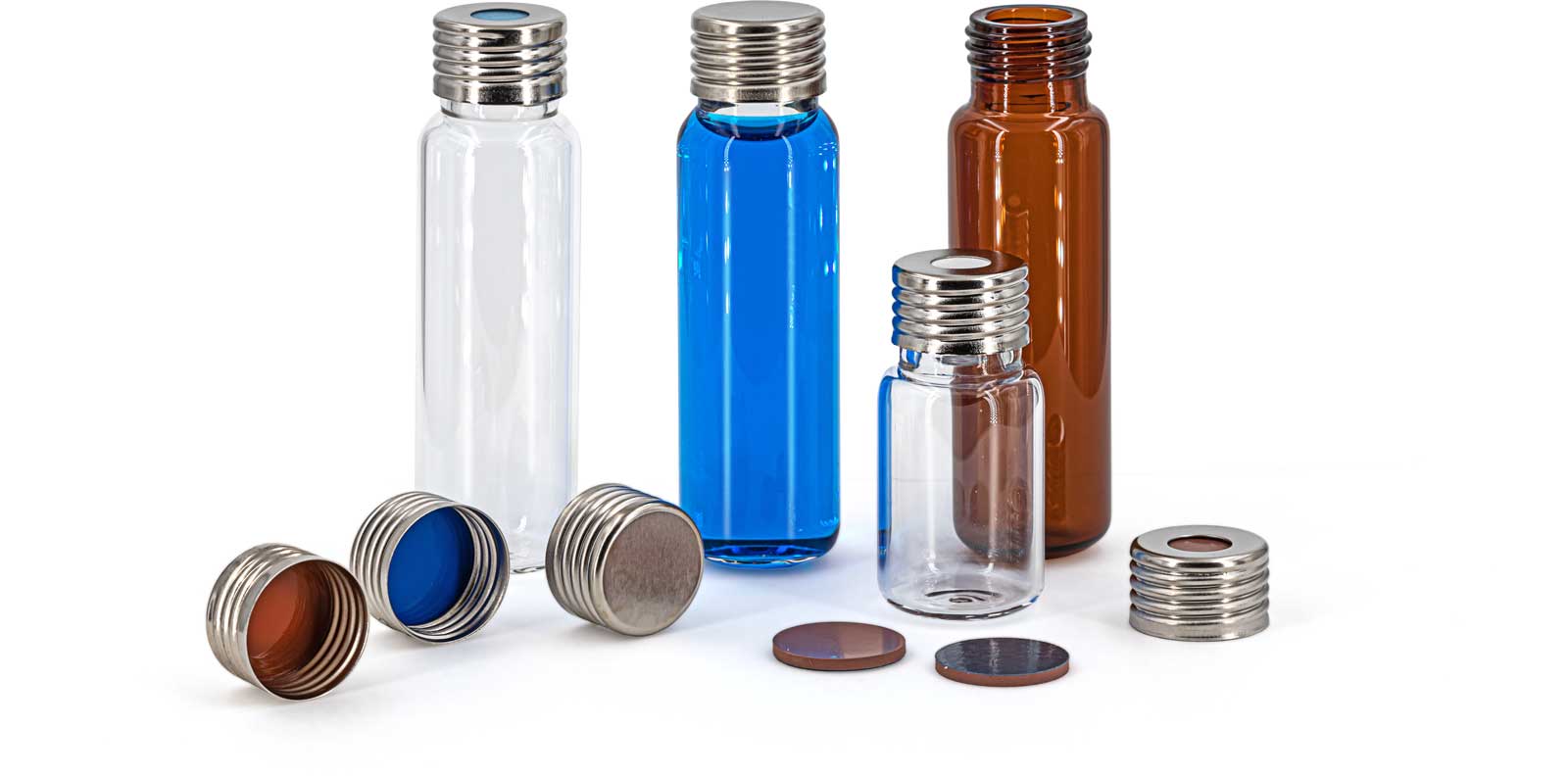
* PAL is a registered trademark of CTC Analytics AG, Switzerland. The MACHEREY-NAGEL products is neither endorsed, nor sponsored by or affiliated with the CTC Analytics AG.
 Screw closure, N 18, metal (magn.), sil., center hole, Silic. w./PTFE blue,1.5mm
Screw closure, N 18, metal (magn.), sil., center hole, Silic. w./PTFE blue,1.5mm  Screw closure, N 18, metal (magn.), silver, c. hole, Red Rubber/TEF, 1.5 mm
Screw closure, N 18, metal (magn.), silver, c. hole, Red Rubber/TEF, 1.5 mm  Screw closure, N 18, metal (magn.),sil.,c. hole,Silicone w./PTFE blue,slit,1.5mm
Screw closure, N 18, metal (magn.),sil.,c. hole,Silicone w./PTFE blue,slit,1.5mm  Screw closure, N 18, metal (magn.), sil.,c. hole,Silicone blue tr./PTFE w.,1.5mm
Screw closure, N 18, metal (magn.), sil.,c. hole,Silicone blue tr./PTFE w.,1.5mm  Screw closure, N 18, metal (magn.),silver,closed top,Silicone w./PTFE blue,1.5mm
Screw closure, N 18, metal (magn.),silver,closed top,Silicone w./PTFE blue,1.5mm  Screw closure, N 18, metal (magn.), silver,center hole,Butyl red/PTFE gray,1.5mm
Screw closure, N 18, metal (magn.), silver,center hole,Butyl red/PTFE gray,1.5mm  Septa N 17, Silicone/PTFE, Blue transparent/white, 1.5 mm, 45° shore A
Septa N 17, Silicone/PTFE, Blue transparent/white, 1.5 mm, 45° shore A  Septa N 17, Silicone/PTFE, Blue transparent/white, 1.5 mm, 45° shore A
Septa N 17, Silicone/PTFE, Blue transparent/white, 1.5 mm, 45° shore A  Screw neck vial, N 18, 22.5x75.5 mm, 20.0 mL, rounded bottom, clear
Screw neck vial, N 18, 22.5x75.5 mm, 20.0 mL, rounded bottom, clear  Screw neck vial, N 18, 22.5x75.5 mm, 20.0 mL, rounded bottom, amber
Screw neck vial, N 18, 22.5x75.5 mm, 20.0 mL, rounded bottom, amber  Screw neck vial, N 18, 22.5x46.0 mm, 10.0 mL, rounded bottom, clear
Screw neck vial, N 18, 22.5x46.0 mm, 10.0 mL, rounded bottom, clear 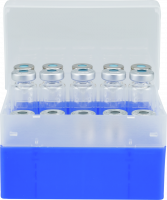 Vial container, max. diameter 23 mm, 25 pos. with lid and divider, stackable
Vial container, max. diameter 23 mm, 25 pos. with lid and divider, stackable 


